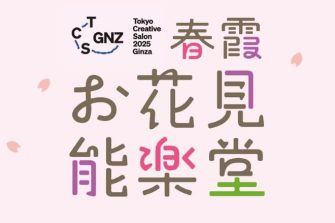
不局限于能剧,作为轻松接触日本传统文化之丰富与深度的场所 Experience the Richness and Depth of Noh Theater and Japan’s Traditional Culture
NOH THEATER
观世清和
迁移至GINZA SIX的想法
43年间,位于涩谷松涛宁静住宅区的观世能乐堂,迁移至传统与创新共存的街道──银座,进驻GINZA SIX这引进最新技术的商业设施中,将代代相守相传的桧舞台搬迁至此,建构了新的能乐堂。
直到四代前的掌门人因为维新而归还领地为止,原本观世大夫(宗家)的宅邸一直都在银座。另外,漫步于街道中,已明显可以感受到年长者渐增,在高龄化的社会里,考虑到要让年轻人更容易接触到日本传统文化的丰富与深度(不仅是能剧),于是决定搬迁。
尤其是现今的时代,我对于“大和心”日渐消失已有危机意识。柔软、柔和、柔韧——这是日本人自古以来的自我认同感,同时也构成了日本人的精神基础。
以《钵木》这出能剧为例。北条时赖乔装云游僧走访诸国。某个冬日,他来到栃木县佐野时,向佐野源左卫门常世请求借宿一晚。常世一家生活落魄、疲弊而衣衫褴褛。问之则答“土地遭人横夺,因而落魄度日。”即便常世生活贫苦,仍为了煮小米饭、以及为云游僧取暖,砍掉了一直以来相当珍惜的梅、松、樱盆栽,当成柴火用。这时候说了一句“这当作今晚的招待”,但绝不是高声唱颂。这就是“大和心”,即使言及“招待”,也并不是将“这就是日本的待客精神”堂而皇之挂在嘴边。
只不过舞出这出能剧的是生为现代人的观世清和。即便想象成观阿弥或世阿弥生活的时代,现代人也应该不可能做出和以前一模一样的事情。因此我认为,顺应时代变化,具备微妙的洞察力,这才是艺道。
What the Relocation to GINZA SIX Means for the Kanze School
The Kanze Nohgakudo, or the Kanze Noh Theater, which has been nestled in the quiet residential neighborhood of Shoto in Shibuya for 43 years, is currently in the process of relocating its storied and hallowed cypress stage to GINZA SIX, a shopping mall with cutting-edge facilities that will open in the heart of Ginza in Spring 2017.
Ginza, a commercial district where tradition and innovation coexist, is technically not a new home for the Kanze School. Historically, the Kanze School was based in Ginza until four generations ago, when the 22nd Grand Master Sanjuro Kiyotaka returned the land to the Japanese government in accordance with the Meiji Restoration [1868]. So in that sense it is a homecoming. The other reason for the relocation is that in an aging society where we see so many senior citizens out and about, I wished to provide a more accessible setting for young people to be exposed not only to Noh, but to the richness and depth of Japan's traditional culture.
In this day and age especially, I can't help but feel that we are losing touch with yamato-gokoro, that is, the spirit of softness, kind-heartedness, and gracefulness that have defined the Japanese identity and formed the bedrock of our psyche since time immemorial.
Consider the Noh play "Hachinoki" ["The Potted Trees"]. Hojo Tokiyori, a regent of the Kamakura shogunate, is traveling incognito throughout Japan, posing as a priest on pilgrimage. One winter's day, as he is passing through the city of Sano in Tochigi Prefecture, a snowstorm causes him to seek shelter from the shabbily-dressed Sano no Genzaemon Tsuneyo, a former lord whose family has been reduced to poverty. Prodded by the priest as to his clan affiliation, Tsuneyo reveals that "Kinsmen usurped my lands, and now I live in misery." Despite his wretched state, Tsuneyo offers the priest some steamed rice with millet, and as the night wears on and grows colder, he cuts down his prized potted plum, pine, and cherry trees and uses the branches to start a fire, saying, "...for this night's entertainment." But he recites this line quietly, almost to himself. That is yamato-gokoro. When the Japanese talk about omotenashi, they mean hospitality that does not draw attention to itself, that does not ask to be recognized.
Of course, when I perform this Noh play I do it as Kiyokazu Kanze, who lives and breathes in contemporary times. Contemplating the times when the founders of Noh—playwrights Kannami [1333-1384] and his son Zeami [1363-c. 1440]—walked the Earth is constructive to an extent, but it is unreasonable to expect someone in the present to recreate a performance in its original form. I believe that the performing arts must possess the adaptability to keep up with the changing times and the insight to understand the subtleties that unfold therein.

具备多国语言的最尖端能乐堂
今年7月,我受到聚集全球优秀舞台艺术的林肯中心艺术节之邀,在纽约罗斯剧院的5天内进行了6场公演,获得了广大好评。海外公演有很多鉴赏力极高的观众,却能得到比日本还高的评价。即使戴了面具,依旧能感受到会场的氛围,观众身子往前倾,专注欣赏表演的样子也感染了我。他们很欣赏能乐的样式美。也许因为是他们没有的世界吧。纽约的人们彻底接受了能剧。
以前在波罗的海三国中的立陶宛演出《葵上》时,8位地谣演员整齐划一地舞扇、唱谣,结束后依旧整齐划一地摆好扇子。看到当时的样式美,同时也是歌剧歌手的文化大臣说道“这让我想起了故乡教会的弥撒。”我很开心他们跨越语言的隔阂,以自由的方式领略能剧。
能剧在海外公演也像歌剧一样,以加上字幕为主流。GINZA SIX当初是采取语音导览的方式,为应对多国语言的需要,预定将整建基础设备。另外我也想积极地引进新能乐堂的重要主题──无障碍空间。多国语言系统也能应用在有视听障碍的来宾身上,用心打造有障碍的人士也能理所当然地欣赏能剧的环境。此外,因为可以取下舞台左侧的柱子,让视野变得宽广,照明方面也整建了以往的能乐堂所没有的设备,所以除了能剧以外,其他类型的公演也可以善加利用这个地方。
希望不分日本及海外,新能乐堂能成为观众们单纯地来看的观赏场所。期盼观众们能先来看看,不要认为“事前不做功课就不能欣赏能剧”。
能剧的歌谣是古语。而且有音节,元音拉长。语言本身的意思也经过变形,连日本人都听不太懂。所以不要用逻辑来理解“为什么舞台有4根柱子?”(笑),我希望大家以自由而丰富的感性来感受。
A State-of-the-Art Nohgakudo With Multilingual Support
This past July, our troupe was invited for the first time to the Lincoln Center Festival, an annual event held in New York hosting some of the best performing arts from around the world. There we conducted six performances over five days at the Rose Theater to much fanfare and acclaim. Performances abroad such as these are attended by discerning, theater-savvy audiences, and we occasionally receive greater acclaim than we do in our native Japan. Even from behind a mask I can feel the energy of the room, and I can imagine the audience leaning forward in their seats. They appreciate the beauty of form on display in Noh theater—perhaps because they are witnessing a world that is completely unfamiliar to them. Truly, the people of New York embraced our art.
Some time ago, we performed "Aoi no Ue" ["The Lady Aoi"] in Lithuania. There is a part where the ji-utai [the eight-member chorus, who sit in two rows stage left] pick up their sensu [Japanese folding fans] in unison, chant the chorus, and then when they are through, set their sensu back down in unison. The Minister of Culture, who also happened to be an opera singer, later said that the ritual had reminded him of attending Mass back in his hometown. I truly appreciated that he had ventured beyond the language barrier and interpreted what he had seen on his own terms.
When performing Noh overseas, we normally feature supertitles to convey to foreign audiences what is happening on stage. At GINZA SIX, we will initially feature English in-ear guidance, with full multilingual support forthcoming. Furthermore, the issue of accessibility, or what we refer to in Japan as barrier-free, is a central focus of the new theater. We will make every effort to provide an environment for guests with disabilities to enjoy Noh—for example, by using our multilingual support system to assist those with visual or hearing impairment. The metsuke-bashira [a pillar placed stage right that serves as a positioning guidepost for dancers] on our stage can be removed to allow for a more unobstructed view, and our stage lighting system is much more adaptable than what you usually find at a Noh theater. We envision our stage being used for performances other than Noh.
The new Nohgakudo will be a place where both Japanese and foreign theatergoers alike can imbibe a visceral experience of our art, free of assumptions and expectations of what it is or should be. No need to do research or study up on the subject matter beforehand—come in fresh, and ask questions later.
Noh recitations are in a very old form of Japanese, and syllables are sung to a fushi [melody, or aria] with long vowel sounds. The meaning of the words are often not meant to be taken literally, rendering the poetry all but indecipherable to even native Japanese. All the more reason why we advise against trying to understand our plays and performances on a purely intellectual level. Why are there four pillars on stage? You're missing the point! (Laughs.) Come in with an open mind and heart, and let your emotions be moved.

新能乐堂理想的景致
我很喜欢华格纳,前年和内人一起参加了拜鲁特音乐节,这是只上演华格纳歌剧的知名艺术节。由华格纳亲自设计,于1876年完成的木造节日剧院,各处都极其出色。
节日剧院位在拜鲁特的宁静山丘上,面向剧院,看到平缓而上的路径,心情也跟着兴奋起来。即便到了开演前5分钟,依旧没有广播,只有钟轻轻地发出了叮叮当当的声音。听到钟声后,原本正在聊天的人们自动进入剧场。负责各个出入口的人员只是站着而已,既没有大声引导,也没有查验门票。寄物处只有一个人负责,却不需要排队等待寄物。
换言之,观众和主办方的关系堪称是建立在默契十足的成熟礼仪上,当下觉得这是欧洲才有的井然有序。
新能乐堂虽然很难马上提供这样的服务,但是亲身体验可以让心灵脱胎换骨。据说GINZA SIX将有典雅的饮食空间。有了绝佳的体验后,葡萄酒和餐点的风味应该也会改变。
我期望新能乐堂或多或少能具有如此的景致。
The Vision for the New Nohgakudo
As a devotee of Wagner's music, I could not pass up an opportunity to attend the Bayreuth Festival in Germany with my wife two years ago. The famous music festival— comprised exclusively of performances of operas by Richard Wagner—is held annually at the Bayreuth Festspielhaus, a wooden theater designed by the 19th-century composer himself and completed in 1876. The grandeur of it all was stunning.
The theater sits atop a peaceful hill in Bayreuth, and the upward slope of the approach evokes a sense of arriving at a higher plane. Inside, there are no announcements made over the PA system—only the modest ringing of a bell to let people out in the lobby know that the performance will begin in five minutes. And with that, the conversations and chit-chat wind down and the last guests saunter into the auditorium. During all of this, the ushers at each door barely move—they're not shouting out instructions, not even checking tickets. The cloakroom is manned by a single attendant, but there's never a line.
Basically, there's an unspoken order to everything, a dignity shared by both the theatergoers and the organizers of the event that puts them in perfect sync. We Japanese have a saying for this: "a-un no kokyuu", but this, I thought, was the kind of savoir-vivre you could only see in a place as cultured and theater-savvy as Europe.
It might be some time before our new theater is able to provide a kind of service on that level, but I have no doubt that the raw, immediate nature of our art can inspire, rejuvenate, and even trigger a spiritual experience. And I hear that GINZA SIX will also offer a number of fine dining options in refined settings. After a Noh performance, you can be sure that food and wine will taste all the richer for it.
That is my vision for the new Nohgakudo. And this is only the beginning.

观世清和
1959年出生于日本东京。其父为二十五世宗家,已故的左近元正。是室町时代能剧集大成者观阿弥、世阿弥的嫡派。其以二十六世观世宗家的身分,带动能乐界。除了日本国内,海外亦有相当多的公演,公演作品包括《箱崎》《阿古屋松》等复刻曲,以及《利休》《圣保罗之感化》等新作。重要无形文化财综合指定保持者。获颁艺术选奖文部大臣新人赏、文部科学大臣赏、传统文化POLA赏大赏、法国艺术文化勲章(骑士)、紫绶褒章等诸多奖项(奖章)。
Kiyokazu Kanze
Born in Tokyo in 1959, Kiyokazu Kanze is the 26th Grand Master of the Kanze School, which claims the closest line of lineage back to Zeami and Kannami, who founded Noh in the Muromachi Period [1336-1573]. He is the eldest son of 25th Grand Master Sakon (Motomasa) Kanze. He has performed across Japan and in many other countries in revived plays such as "Hakozaki" and "Akoyanomatsu", and the new Noh plays "Rikyu" and "The Conversion of St. Paul". He has been designated as part of an Important Intangible Cultural Property of Japan, and is the recipient of numerous other awards and honors, including the Minister of Education’s Art Encouragement Prize and previously its Prize for New Artists, the Pola Award for Traditional Culture, Knight of the Order of Arts and Letters (Chevalier dans l'Ordre des Arts et des Lettres) by the French government, and the Medal of Honor with Purple Ribbon from the Japanese government.
(2016年9月采访)
Interview and Text by Yuka Okada / Photographs by Satoko Imazu










